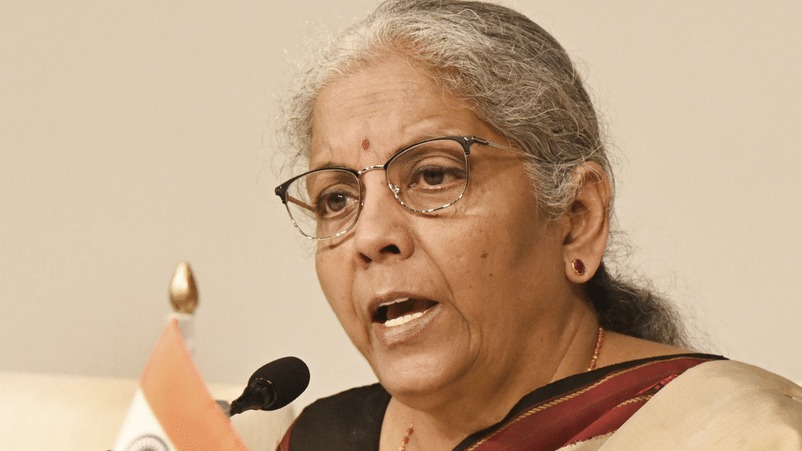
New Delhi: Union Finance Minister Nirmala Sitharaman on Thursday launched a scathing attack on the DMK-led Tamil Nadu government over its decision to replace the rupee symbol (‘₹’) with the Tamil letter ‘ru’ in the Tamil Nadu Budget 2025-26 documents. She said the move signals a "dangerous mindset that weakens Indian unity" and fosters secessionist sentiments under the pretext of regional pride.
The controversy erupted as the Tamil Nadu government released the official logo for the state budget, scheduled to be presented on Friday, March 15. The logo omitted the ₹ symbol and instead featured ‘ru,’ derived from the Tamil word ‘Rubaai’, which means rupee in the Tamil language.
Sitharaman: "Why Didn’t DMK Protest in 2010?"
Sitharaman questioned DMK’s sudden opposition to the rupee symbol, pointing out that it was officially adopted in 2010 when the DMK was part of the UPA alliance at the Centre.
"Why didn’t DMK protest back then? The rupee symbol was approved by a government they were part of. This deliberate move now is nothing but language and regional chauvinism," she tweeted.
Ironically, she added, the rupee symbol itself was designed by a Tamilian, D. Udaya Kumar, the son of former DMK MLA N. Dharmalingam.
“By erasing it now, the DMK is not only rejecting a national symbol but also utterly disregarding the creative contribution of a Tamil youth,” she said.
“This Weakens National Integrity”
Sitharaman expressed concern over the larger implications of this move, stating that removing the ₹ symbol from official budget documents is a direct challenge to India's national unity.
“This is more than mere symbolism – it signals a dangerous mindset that weakens Indian unity and promotes secessionist sentiments under the pretence of regional pride.”
She further reminded the elected representatives in Tamil Nadu that they had taken an oath to uphold the sovereignty and integrity of India.
"Removing a national symbol from the State Budget goes against that very oath and weakens our commitment to national unity," she said.
The Rupee’s Deep Roots in Tamil and Indian History
Sitharaman also provided a historical perspective, highlighting how the Tamil word ‘Rupaai’ has deep roots in Sanskrit.
- The word ‘Rupaai’ originates from the Sanskrit term ‘Rupya,’ meaning “wrought silver” or “a worked silver coin”.
- This term has been in Tamil trade and literature for centuries.
- Even today, ‘Rupaai’ is used to denote currency in Tamil Nadu and Sri Lanka.
She also pointed out that several countries, including Indonesia, the Maldives, Mauritius, Nepal, Seychelles, and Sri Lanka, officially use ‘Rupee’ or its equivalent derivatives as their currency name.
“Should We Undermine Our Own National Currency Symbol?”
Sitharaman strongly criticized DMK’s move, emphasizing the global recognition of the rupee symbol.
“The rupee symbol is internationally well-recognized and serves as a visible identity of India in global financial transactions.”
She also highlighted that India is currently pushing for cross-border payments using UPI and questioned whether this was the right time to undermine the rupee’s identity.
"At a time when India is expanding its financial footprint globally, why should we create unnecessary divisions at home?"
Political Reactions and Public Opinion
This controversy has sparked intense debates on social media, with many supporting Sitharaman’s argument, while others defend the Tamil Nadu government’s decision as a regional representation of currency.
While DMK leaders have not yet responded, political experts believe that this move may further strain relations between the state and the Centre.
What’s Next?
With the Tamil Nadu Budget 2025-26 set to be presented on Friday, March 15, all eyes are now on how the state government justifies its decision and whether the Centre takes any further action on the issue.
What is the controversy about?
The DMK government has removed the official rupee symbol (₹) from Tamil Nadu Budget 2025-26 documents and replaced it with the Tamil letter ‘ru’ (short for ‘Rubaai’).
Why is the rupee symbol important?
The ₹ symbol, officially adopted in 2010, represents India's financial identity globally. It is recognized in international transactions and financial systems.
Is this the first time a state has done this?
Yes, this is the first instance of a state government removing the ₹ symbol from official financial documents.
How did the rupee symbol originate?
The ₹ symbol was designed by D. Udaya Kumar, a Tamilian, and was officially adopted in 2010 by the UPA government, which included DMK.
What will happen next?
The Tamil Nadu Budget will be presented on March 15, and further political reactions are expected from both DMK leaders and the central government.

 Share
Share
_458360041_124x80.jpg)


